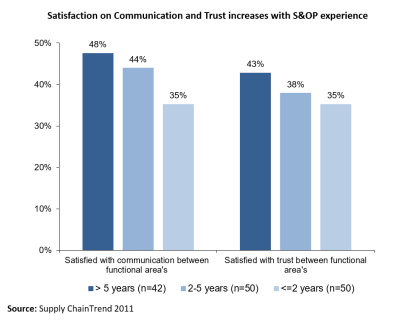Great companies do not only have a clear ‘why’ or purpose. They don’t just have a clever differentiating strategy, which they execute seamlessly. Great companies also know very well ‘how’ they ought to behave whilst going about their daily tasks to execute their strategy. Not just to improve business performance, but also to improve employee well-being. And although there is not just one clear behavior that is most effective for every business, trust is a recurring theme and paramount in both effective leadership, improved business results and employee well-being.
The massive impact of Trust
According to Amy Cuddy, trust is by intuition the first thing people seek when they meet somebody new. Teams without trust fear conflict, have a lack of commitment, avoid accountability and show an inattention to results. From business performance perspective, trust has a direct impact on strategy execution and trust is one of the most important predictors of positive organizational outcomes.
Trust in management positively effect psychological well-being. When leaders display trust behaviours, they will also increase psychological safety, a shared belief where team members feel accepted and respected. Research from Google in over 180 over their own teams show that psychological safety is by far the biggest contributor to team effectiveness.
In the Speed of Trust, Covey discusses eighteen behaviours that foster trust. The latest research from neuroscientist Paul Zak now shows there are eight measurable behaviours that most stimulate trust. Zak found that compared to low-trust companies, people at high trust companies report: 74% less stress, 106% more energy at work, 50% higher productivity and 29% more satisfaction with their lives. Nothing less than a mindblowing impact of trust.
S&OP and trust
In the article Corporate culture and S&OP: why culture counts, Trustworthiness is mentioned as a key cultural element to support S&OP by professor John Mello.
In an extensive review of 99 S&OP articles, Tuomikangas and Kaipia list culture and leadership as one of six mechanisms to improve S&OP performance. This sixth mechanism aims at creating an organizational culture favorable for successful S&OP implementation. It includes the organizational mindset and practices that facilitate and advance formal planning, which include trust.
Trust is acknowledged to improve S&OP, business performance and employee well-being. However, my S&OP Pulse Check shows that even with more than five years of S&OP experience, less than 50% of survey participants indicate they are satisfied with the levels of trust and communication.
With less than 50% of S&OP stakeholders showing satisfaction in important fundamental as trust an S&OP foundation remains fragile. Trust is a must in the journey to achieve S&OP excellence.
The CEO as trust blocker
Knowing all these trust benefits, what company would not have trust building as core value, as key focus to develop S&OP or as a general major company initiative? CEO’s who don’t focus on building trust, have to ask themselves if they have the interest of employee well-being and company performance at heart.
CEO’s who don’t focus on building trust, have to ask themselves if they have the interest of employee well-being and company performance at heart.
Sometimes the CEO can be the biggest obstacle in building trust. As S&OP manager, I once organized workshops with the top 40 leadership team to discuss how to improve trust. With cross functional teams, we discussed personal stories and used Covey’s list of trust behaviours to distill four themes that we presented back to the CEO. One of the key themes was; ‘fear of speaking up’. There was a general notion in the top 40 leaders that it was hard to disagree publicly, challenge the status quo or even share your own different thoughts. An obvious case of a lack of psychological safety. This will often lead to dysfunctional decision making due to groupthink, less effective business. S&OP excellence will not be able to be achieved.
When the results were presented back to the CEO, he welcomed three themes and agreed to start working on them. However, he dismissed the fear theme as nonsense, as his perception was that ‘everybody can say what they want’. This CEO was eager to talk about improving collaboration to increase company performance. However, this CEO missed the opportunity to address a lack of psychological safety in his company, by far the biggest contributor to team effectiveness.
The role of the Chief Trust Officer
This is where the Chief Trust Officer would step in. The CTO would call out the flawed thinking of the CEO. The CTO, a coach with significant business experience, knowledge of effective behaviours or organizational psychology, will also provide feedback to a CEO in lacking self-awareness, flawed self-perceptions, or ineffective behaviours.
A Chief Trust Officer’s role can include to help organize and implement trust building initiatives, but a CTO would mainly take a coaching role to improve trust building behaviours in executives. The CTO would observe S&OP and leadership team meetings and would explore how publicly displayed behaviours from the leadership team dripple down into the organization. The CTO would observe trust destroying behaviours and start coaching at the top to change these. The CTO would help to nurture existing trust building behaviours.
The science of trust
The CTO knows that building trust requires soft skills, but is also getting more factual. Through neuroscience, we know that breaking trust fires up the amygdala, our primitive part of the brain, activates our flight or fight response and creates stress hormones cortisol and adrenaline. Being in a state of fight or flight hijacks our ability to have meaningful conversations and is proven not to be good for health and well-being. However, a CTO can teach executives to detect flight or fight responses, self-manage and manage others by downregulating these emotions and replace them.
We also know that trust gets managed in our prefrontal cortex, the executive part of the brain, where the more strategic social skills reside. This is where oxytocin is produced, a bonding hormone that increases trust. A CTO can teach executives how to activate the prefrontal cortex and create oxytocin in themselves or in others. This can be done by having conversations about shared values, an engaging vision, being vulnerable, show that you personally care, grow your people, showing compassion, gratitude or kindness.
Conclusion
I once defined the 5th and final phase of S&OP maturity ’emotionally competent’. The self-aware leader who knows their own emotional triggers, who can read the triggers and emotional response in others, and has the ability to use emotions intelligently, can regulate trust. It would be the ultimate objective of the Chief Trust Officer to develop a critical mass of leaders who have trust managing capability and are authentic about building trust. With a critical mass of trust-aware and trust-managing leaders, an organization might have a chance to reap all its business performance, productivity and employee health & well-being benefits.



Very important article that I plan to share with my organization. However, you should have someone revise the English grammar and usage; several times you use the verb “learn” when you should use “teach”.
Thanks Carl, feel free to replace learn with teach, train, educate where you require. Let me know what your organisation thinks about it
Niels, This was a good read. Related to the topic of trust, a book recommendation, actually my favorite business book of all time, “The Trust Factor: Liberating Profits & Restoring Corporate Vitality”, published in 1994, yes 1994, the author John O Whitney, a Deming disciple. The author does a great job of covering this topic in a relatively short, very entertaining, easy read, and believe it or not, the content in this book is still very relevant today, as in 1994. I am not here to promote books, authors, or Amazon, but thought you and your readership might find this of some value and interest related to the topic of trust. Here is a link to the Amazon site for this book (note, because of it’s age, this book appears to be in short supply), https://www.amazon.com/dp/0070700176?_encoding=UTF8&isInIframe=0&n=283155&ref_=dp_proddesc_0&s=books&showDetailProductDesc=1#product-description_feature_div
Thanks for the book tip someone
Niels, Greetings, I inadvertently posted my original post as anonymous by mistake, I am the author of this post, “This was a good read. Related to the topic of trust, a book recommendation, actually my favorite business book of all time, “The Trust Factor: Liberating Profits & Restoring Corporate Vitality”, published in 1994, yes 1994, the author John O Whitney, a Deming disciple. The author does a great job of covering this topic in a relatively short, very entertaining, easy read, and believe it or not, the content in this book is still very relevant today, as in 1994. I am not here to promote books, authors, or Amazon, but thought you and your readership might find this of some value and interest related to the topic of trust. Here is a link to the Amazon site for this book (note, because of it’s age, this book appears to be in short supply), https://www.amazon.com/dp/0070700176?_encoding=UTF8&isInIframe=0&n=283155&ref_=dp_proddesc_0&s=books&showDetailProductDesc=1#product-description_feature_div “
Thanks for the book reference Jim